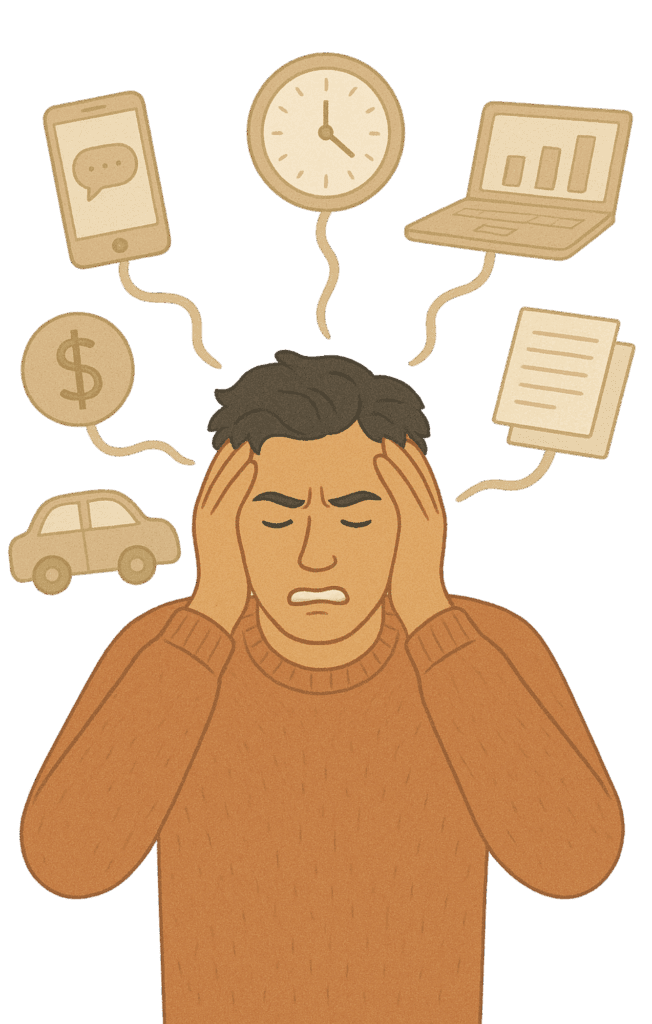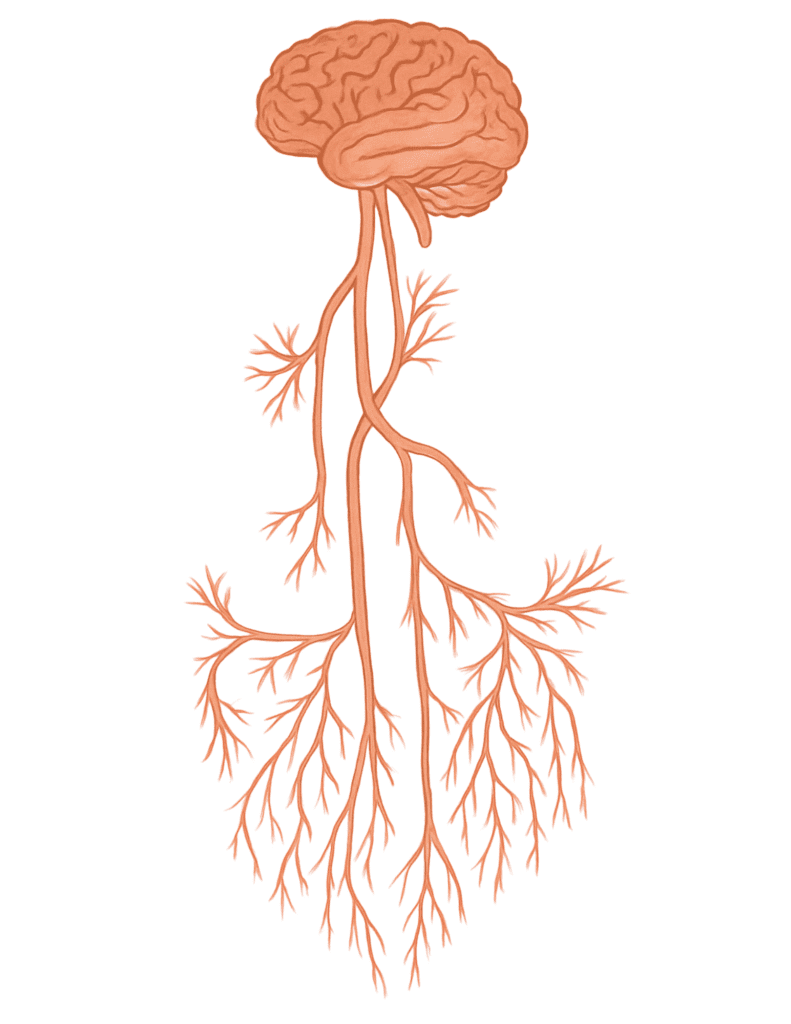Feeling Stuck in Talk Therapy? Here’s What Might Be Missing
You’ve been showing up to therapy consistently for months, maybe even years. You’ve talked through your childhood, analyzed your thought patterns, and maybe you’ve gained valuable insights about yourself (& maybe you haven’t). Yet somehow, those persistent symptoms of anxiety or depression still linger. The panic attacks continue. That feeling of being disconnected from yourself remains.

Something we hear a lot is, “therapy is helping me figure out why I’m struggling but not what to do to actually get better.”
If this sounds familiar, you’re not alone—and you’re not failing at therapy. Instead, there might be a critical missing piece in your healing journey: your nervous system.
The Mind-Body Disconnect in Traditional Therapy
Traditional talk therapy—while deeply valuable—tends to focus primarily on thoughts, emotions, and behaviors. Approaches like cognitive behavioral therapy (CBT) teach you to recognize and reframe distorted thinking, based on the idea that unhelpful thoughts drive unhelpful feelings and actions.
And for many, this works. CBT and similar approaches have helped millions. But if you’re dealing with chronic anxiety, depression, or trauma, you might still feel like something’s missing.
Here’s why: roughly 80% of the communication between the body and brain travels from body to brain—not the other way around. So if your healing approach only targets the mind, you’re likely leaving out the part of you that’s doing most of the talking.
Talk therapy works with the cognitive brain—your thoughts, beliefs, and inner narratives. But many of the symptoms that keep people stuck (like panic, shutdown, or emotional numbness) are rooted in physiological dysregulation within the nervous system.
And here’s the catch: your nervous system doesn’t respond to insight—it responds to felt safety.
If your body is stuck in hypervigilance, chronic stress, or freeze, you may not even have access to the tools therapy is trying to give you—things like curiosity, reflection, and behavioral flexibility.
As I often say to clients: There’s no amount of talk therapy that can resolve anxiety caused by a nutrient deficiency, stored survival stress, or chronic sleep deprivation. And no antidepressant can truly heal depression rooted in isolation, trauma, or a sedentary lifestyle.
If you keep hitting a wall in therapy, the problem might not be your mindset—it might be your physiology.
Understanding the Nervous System Gap

When we experience prolonged stress, trauma, or even the everyday pressures of modern life, our nervous systems can become dysregulated. According to somatic experiencing and polyvagal theory, the body can actually get stuck in trauma response mode. Even when the threat is gone, the body still perceives danger and its defenses stay engaged.
This explains why you might intellectually understand that you’re safe, yet your body continues to respond as if you’re in danger—with racing heart, shallow breathing, muscle tension, and heightened alertness.
Traditional therapy often misses this critical physiological component. While talk therapy mainly focuses on thoughts and emotions, somatic or body-based approaches pay attention to what your body is feeling and how your nervous system has been impacted.
The Physiology-First (But Not Physiology-Only) Approach
At Regulated Living, we take what I call a “physiology-first, but not physiology-only” approach to mental health. As I explained in my podcast:
Think of it this way: your body and your mind are constantly communicating. If your body is depleted—if you’re dealing with nutrient deficiencies, hormonal imbalances, chronic inflammation—it directly impacts your brain function and your nervous system regulation. You can’t simply “mindset” your way out of a nervous system that’s stuck in survival mode.
At the same time, psychological factors are just as important. Past trauma, chronic stress, unhealthy relationships, limiting beliefs, a lack of purpose—these all contribute to nervous system dysregulation and keep us in that state of survival.
This integrated approach looks at the whole picture of what’s happening in your body, mind, and life circumstances.
What Comprehensive Healing Includes
If you’re feeling stuck in traditional therapy, here’s what a more complete approach might include:
1. Nervous System Regulation
Learning to recognize your nervous system states and developing tools to shift between them is fundamental. The state of your nervous system affects how you respond to the world. You learn about this both inside the membership and RESTORE, our 1:1 coaching program.
Rather than just talking about your anxiety, you learn to recognize what’s happening in your body when anxiety strikes and develop practical tools to regulate your physiology in the moment.


2. Physical Health Optimization
When my dog was acting strange the very first thing the vet said was, “Let’s do some labwork to make sure nothing is off under the surface.” Far too often people (myself included) are prescribed meds of given mental health diagnosis without ever considering or testing their physical health. Comprehensive bloodwork is something we include for all of our 1:1 coaching clients. If often reveals things like a vitamin D deficiency or thyroid imbalance, which contribute to anxiety and depression symptoms. Also, general health habits like movement, nutrition, sleep, all play a huge role in our psychology. Addressing these physiological factors alongside psychological ones creates a more complete healing plan.
Many mental health symptoms are connected to underlying physical issues that no amount of talk therapy alone can resolve.
3. Body-Based Approaches
Somatic therapy processes emotions trapped in the body through various techniques like breathwork, movement, and becoming aware of bodily sensations. This allows emotions to move through the nervous system instead of remaining stuck.
These approaches help you connect with and process emotions not just intellectually, but through the body, where they’re often stored, in a felt, experiential way.

4. Integration of Multiple Dimensions
As I’ve shared on my podcast: An effective long-term healing plan explores, addresses, and integrates multiple arenas in our lives:
- Physical health: Through understanding your physiology, optimizing your bloodwork, and creating supportive lifestyle habits
- Mental health: Through addressing thought patterns, beliefs, and developing emotional regulation skills
- Embodied Health: Through somatic approaches that directly cultivate interoceptive awareness and engage with how trauma and overwhelming experiences are held within the body. This supports the resolution of stuck survival patterns, enables the nervous system to reprocess and integrate these deeply held imprints, and allows you to feel more connected in your everyday life.
- Relational health: Through building connection, boundary-setting, and creating safety in relationships
- Environmental health: Through adjusting your surroundings to better support your nervous system
When you understand this interconnection, you recognize how a good night’s sleep might be just as important for your anxiety as addressing a limiting belief, or how addressing nutrient deficiencies might be as crucial for depression as talking through it, and how integral a somatic approach is to trauma healing.
How to Know If Your Nervous System Needs Attention
Consider these signs that your nervous system might be the missing piece in your therapy:
- You understand your patterns intellectually but still feel stuck in them physically
- You experience persistent physical symptoms alongside your emotional ones (tension, digestive issues, fatigue, sleep disturbances)
- You feel disconnected from your body or have difficulty identifying sensations
- Traditional relaxation techniques often make you feel worse rather than better
- Your symptoms intensify in certain environments or around certain people without clear cognitive reasons
The Power of a Complementary Approach
It’s important to note that nervous system-informed approaches don’t replace traditional therapy—they complement it and sometimes are the better fit for wherever someone is in their healing journey. Polyvagal theory encourages a holistic approach, considering not only cognitive and emotional aspects but also the physiological responses of the nervous system, enabling therapists to address the mind-body connection for overall well-being.
The most effective healing often comes from integrating multiple approaches:
This is why our approach is so comprehensive. We look at the whole person—mind, body, and life circumstances—to create a personalized healing plan.
Your anxiety or depression isn’t random, it isn’t a character flaw, and it isn’t something you should just “get over” or accept as unchanging for the rest of your life. Most often they are normal responses to abnormal circumstances.
Taking the Next Step
If you’ve been feeling stuck in traditional therapy, consider exploring approaches that incorporate the nervous system. This might include:
- Finding a practitioner trained in somatic or body-based approaches
- Learning basic nervous system regulation techniques like specific breathing patterns, grounding exercises, or vagus nerve stimulation
- Getting comprehensive bloodwork to identify any physiological contributors
- Complementing your talk therapy with movement practices like yoga, tai chi, or dance
- Joining our Regulated Living programs for a structured approach to nervous system healing
Remember that feeling stuck doesn’t mean you’re failing or that healing isn’t possible. The journey of healing through a nervous system lens is ultimately about reclaiming connection with yourself. It’s about creating enough safety in your system that you can once again feel like yourself, accessing your inner wisdom, creativity, joy, and resilience.
Your symptoms make sense given your experiences, and with the right approach that honors both mind and body, you can find your way forward.
Ready to Learn More?
If you’re curious about how a nervous system approach could complement your current therapy, here are some next steps:
- Tune in to the Regulate & Rewire Podcast (the Back to the Basics series is a great place to start, Ep. 101)
- Explore our other blog posts about nervous system regulation
- Sign up for our newsletter to receive practical regulation tips
- Book a free discovery call to discuss if RESTORE, our 1:1 coaching program is a good fit
Your healing journey deserves every tool available—mind and body working together toward wholeness.
This article is for informational purposes only and is not a substitute for professional medical advice, diagnosis, or treatment. Always seek the advice of your physician or qualified mental health provider with any questions you may have regarding a medical condition.
Leave a Reply Cancel reply
A mental health newsletter that feels like a deep breath: simple, grounding, and here to remind you that healing is possible.
The Weekly Rewire
Navigate
Regulated Living provides neuroscience-backed mental health coaching to help you regulate your nervous system and reclaim your life from anxiety and depression.
Heal
Learn
Paragraph